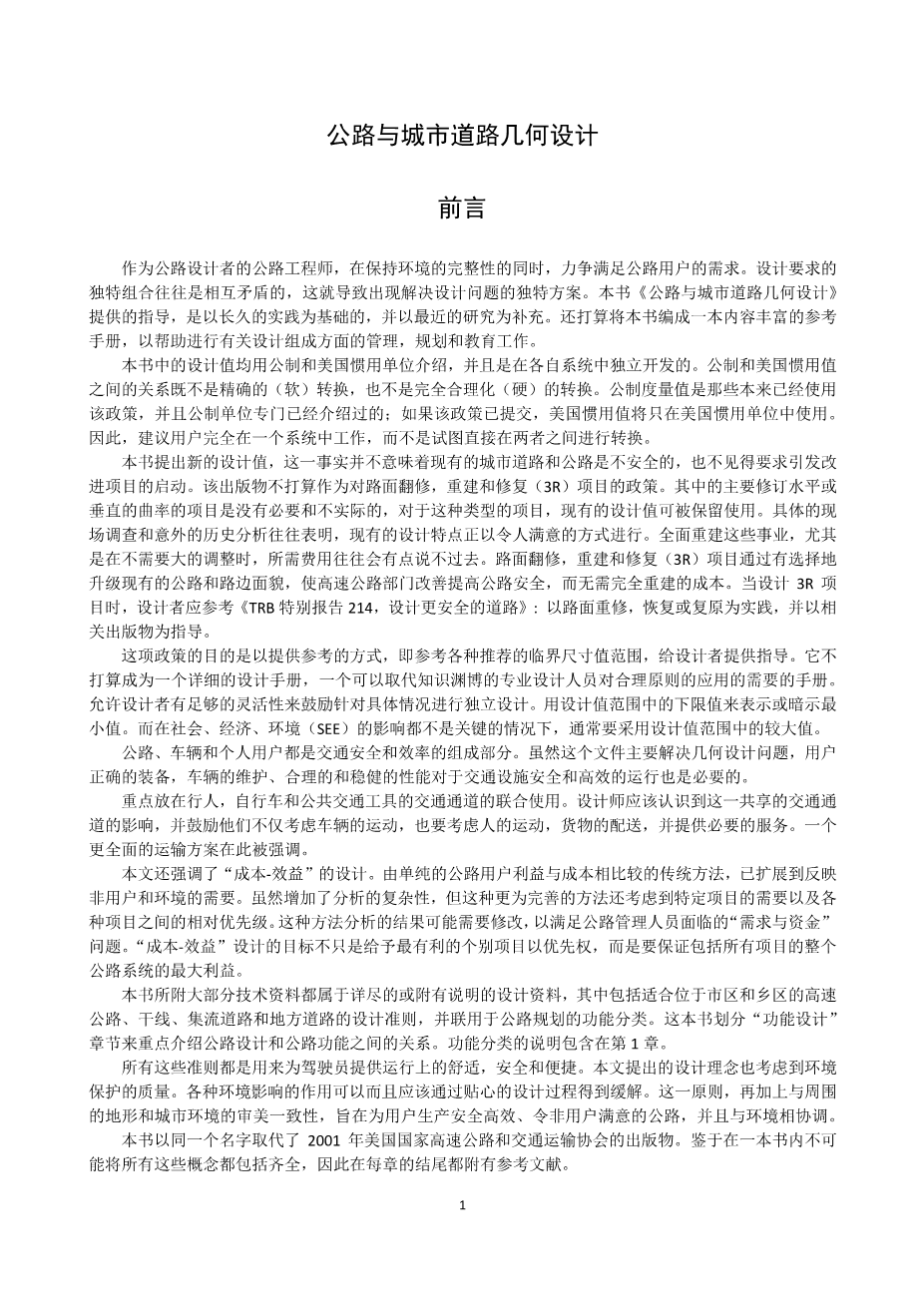新建公路设计(四)外文翻译资料
2022-10-25 11:59:28
A Policy on Geometric Design of Highways and Streets
Foreword
As highway designers, highway engineers strive to provide for the needs of highway users while maintaining the integrity of the environment.Unique combinations of design requirements that are often conflicting result in unique solutions to the design problems.The guidance supplied by this text, A Policy on Geometric Design of Highways and Streets, is based on established practices and is supplemented by recent research.This text is also intended to form a comprehensive reference manual for assistance in administrative, planning, and educational efforts pertaining to design formulation.
Design values are presented in this document in both metric and U.S. customary units and were developed independently within each system.The relationship between the metric and U.S. customary values is neither an exact (soft) conversion nor a completely rationalized (hard) conversion.The metric values are those that would have been used had the policy been presented exclusively in metric units; the U.S. customary values are those that would have been used if the policy had been presented exclusively in U.S. customary units.Therefore, the user is advised to work entirely in one system and not attempt to convert directly between the two.
The fact that new design values are presented herein does not imply that existing streets and highways are unsafe, nor does it mandate the initiation of improvement projects.This publication is not intended as a policy for resurfacing, restoration, or rehabilitation (3R) projects.For projects of this type, where major revisions to horizontal or vertical curvature are not necessary or practical, existing design values may be retained.Specific site investigations and crash history analysis often indicate that the existing design features are performing in a satisfactory manner.The cost of full reconstruction for these facilities, particularly where major realignment is not needed, will often not be justified.Resurfacing, restoration, and rehabilitation projects enable highway agencies to improve highway safety by selectively upgrading existing highway and roadside features without the cost of full reconstruction.When designing 3R projects, the designer should refer to TRB Special Report 214, Designing Safer Roads: Practices for Resurfacing, Restoration, and Rehabilitation and related publications for guidance.
The intent of this policy is to provide guidance to the designer by referencing a recommended range of values for critical dimensions.It is not intended to be a detailed design manual that could supercede the need for the application of sound principles by the knowledgeable design professional.Sufficient flexibility is permitted to encourage independent designs tailored to particular situations.Minimum values are either given or implied by the lower value in a given range of values.The larger values within the ranges will normally be used where the social, economic, and environmental (S .E.E.) impacts are not critical.
The highway, vehicle, and individual users are all integral parts of transportation safety and efficiency.While this document primarily addresses geometric design issues, a properly equipped and maintained vehicle and reasonable and prudent performance by the user are also necessary for safe and efficient operation of the transportation facility.
Emphasis has been placed on the joint use of transportation corridors by pedestrians, cyclists, and public transit vehicles.Designers should recognize the implications of this sharing of the transportation corridors and are encouraged to consider not only vehicular movement, but also movement of people, distribution of goods, and provision of essential services.A more comprehensive transportation program is thereby emphasized.
Cost-effective design is also emphasized.The traditional procedure of comparing highway- user benefits with costs has been expanded to reflect the needs of non-users and the environment.Although adding complexity to the analysis, this broader approach also takes into account both the need for a given project and the relative priorities among various projects.The results of this approach may need to be modified to meet the needs-versus-funds problems that highway administrators face.The goal of cost-effective design is not merely to give priority to the most beneficial individual projects but to provide the most benefits to the highway system of which each project is a part.
Most of the technical material that follows is detailed or descriptive design information.Design guidelines are included for freeways, arterials, collectors, and local roads, in both urban and rural locations, paralleling the functional classification used in highway planning.The book is organized into functional chapters to stress the relationship between highway design and highway function.An explanation of functional classification is included in Chapter 1.
These guidelines are intended to provide operational efficiency, comfort, safety, and convenience for the motorist.The design concepts presented herein were also developed with consideration for environmental quality.The effects of the various environmental impacts can and should be mitigated by thoughtful design processes.This principle, coupled with that of aesthetic consistency with the surrounding terrain and urban setting, is intended to produce highways that are safe and efficient for users, acceptable to non-users, and in harmony with the environment
This publication supersedes the 2001 AASHTO publication of the same name.Because the concepts presented could not be completely covered in one book, references to additional literature are given at the end of each chapter.
CHAPTER 1
HIGHWAY FUNCTIONS
SYSTEMS AND CLASSIFICATIONS
The classification of highways into different operat
剩余内容已隐藏,支付完成后下载完整资料


英语原文共 14 页,剩余内容已隐藏,支付完成后下载完整资料
资料编号:[151905],资料为PDF文档或Word文档,PDF文档可免费转换为Word




